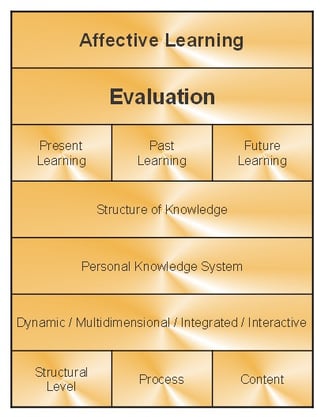Published on
Affective Learning Projects and Prior Learning

Comparative evaluation is the foundation of conventional competitive schools, colleges and universities. The assumption is that we all have different abilities and we can put numbers on that ability. Even though it has no logical foundation, we still use standardized testing to rationalize our inadequate education systems, and the idea has become so ingrained in society that we take it for granted. The little we know about brain function suggests that we all have enormous capacity to learn if the circumstances are right; and ratings like “IQ” probably measure superficial learning and have nothing at all to do with the acquisition of real knowledge.
Yet we have no alternative way to measure knowledge, so we keep on using the traditional approach. We have modified the conventional IQ model a bit by creating rating scales, but it is just a different perspective on the same idea. Evaluation of affective learning offers a real alternative to conventional evaluation because it evaluates the entire learning picture, not just the outcomes of learning. Its focus on integrating past learning makes it ideal for returning, lifelong learners.
Present Learning
Affective learning requires that projects are meaningful for students by making sure that everything is done in context. In order for learning to happen, the student must be able to relate the learning to the environment around them. This is why projects are the best vehicle for learning. So the nature of the learning environment becomes part of the evaluation picture.
Past Learning
Affective learning takes past learning experiences into account. A student may not like a specific subject because past experience with that subject has been negative. It is important to understand that past learning is not the same as prerequisite learning. Past learning has to do with the value the student puts on previous learning experiences. If there is negativity about present learning because of past experience, then that becomes part of the evaluation picture.
Affective learning not only requires a present context for learning, it also requires a tentative future context for learning. We can work around “learned negativity” about learning by making the purpose of learning part of the learning context. It is important to understand this purpose for learning is not advising the student as to what to do; it is what he or she wants. This then becomes part of the evaluation picture.
Structure of Knowledge
Learning projects should be designed and carried out against the backdrop of the structure of knowledge as described in previous articles. A person should be able to look at the structure of knowledge and see how what they are learning fits into the bigger picture. So it is important to design learning projects to fit the structure of knowledge. This also becomes part of the evaluation picture.
Personal Knowledge System
Students should be aware of their personal knowledge systems. Every learner should be able to use the structure of knowledge as the backdrop to describe what they already know and learning projects should be rationalized in terms of enhancement of current knowledge. Rather than specifying specific prerequisite knowledge for present learning, we should look at how current knowledge can be used creatively to support new learning. If we can use current knowledge to motivate new learning, we can integrate related knowledge into projects. Motivation is more important than prerequisite knowledge when we are looking at a series of projects for a given education or training program. So the linkages of learners to projects become part of the evaluation picture.
Dynamic / Multidimensional / Integrated / Interactive
Those four words describe learning and they reflect the true complexity of the learning process. Ultimately learning should build confidence, but it is much easier to find reasons why learning does not happen than it is to find ways to ensure it happens. The atmosphere of the learning environment is critical and it should be the highlight of evaluation. Interesting, engaging, encouraging attitudes and recognition of individual value among learners and teachers is essential. Recognition that true knowledge development is incremental and takes time to accomplish. Superficial learning designed to pass tests should be completely rejected.
Structural Level
The structure of knowledge has a nine element learning process that is applied at five functional levels of learning. It is important to recognize that functional learning climbs up the five levels of the hierarchy as different projects are done and repeated. Initial learning, using knowledge, organizing knowledge, personalizing knowledge, and proliferating knowledge happens as projects are done. We continuously manage knowledge. This shows up in the learner’s ability to plan and strategize. The student should be evaluated on those skills.
Process
Each project has a process that is reflective of the way we learn. So doing affective learning projects should inherently build self-directed learning skills. Working alone or in groups, students should be evaluated on their ability to do it themselves. The instructor intervenes only to ensure this is happening. The objective is to bring out the natural ability to learn that exists in each and every one of us. We learn how to learn.
Content
Even though knowledge is expanding exponentially, we still need to know the knowledge of the day. We still need knowledge to live and work and there are also certification requirements. What we know has to be evaluated too. However, it should not be done as a competition. Competition serves no purpose from a learning perspective. In the context of affective learning projects, knowledge content will be developed inherently. We can be reassured by testing, but there are many aspects of knowledge that cannot be tested and we must always bear that in mind when requiring answers to specific questions.
It must seem like a formidable task to evaluate natural learning, but if most teachers stop and think about it, many already do it intuitively. The problem is that it is not recognized as evaluation because it is difficult to measure. We only give credit for content evaluation that we believe we can measure and the bigger picture is ignored. In affective learning e-schools, every aspect of the teaching / learning process is considered. Qualitative measurement overrides quantitative measurement. The focus is on creating, maintaining and continuously improving a functional affective learning system.
Author Perspective: Business




